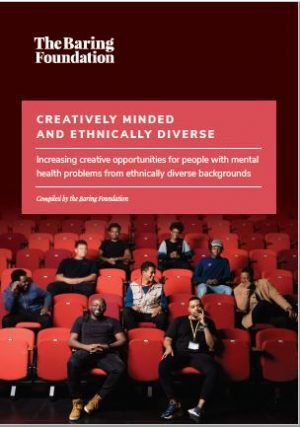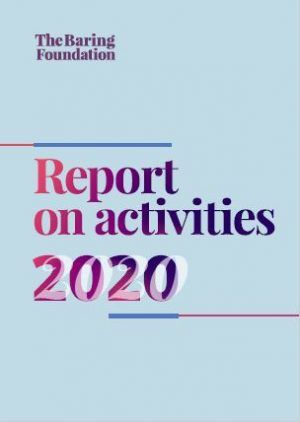Sandra is the founder of West Midlands-based The Red Earth Collective which uses the arts to inspire stories, stimulate thinking and create conversations that support and improve the mental health and wellbeing of marginalised and racialised communities. The Red Earth Collective was awarded a grant from the Foundation in our first grants round of the Arts and Mental Health programme in Autumn 2020.
Sandra was interviewed by the Baring Foundation’s Communications & Research Officer, Harriet Lowe for our 2020 Annual Report and Red Earth also features in our new report Creatively Minded and Ethnically Diverse.
You founded The Red Earth Collective – what led you there?
I’ve always been interested in the arts in one shape or form; initially more as a consumer than creator, but as I’ve got older I have to the desire to create and write more and more. Back in 2000, I was working at the East London Foundation Trust and was responsible for setting up a project looking at the overrepresentation of Afro-Caribbean men in mental health services with a group of staff, voluntary sector organisations and people with lived experience. I remember there was one colleague in the group, Philip. He was a spoken word artist, a poet, and he was always coming to meetings and sharing a poem or spoken word piece. It felt like the arts challenged how people saw him. He was a Black man, had a history of homelessness and had become mentally unwell. He never really spoke about it, but it came out through his creativity. I decided I wanted to create creative programmes that would engage Black men. I thought let’s bring something different, some creativity to this space; let’s interrupt it!
I thought let’s bring something different, some creativity to this space; let’s interrupt it!
Philip was one of the main reasons why I did it. I saw how it brought him to life. He wasn’t Philip, ex-service user; he was Philip the artist. When people find the right creative form, they can become a creative and no longer just someone living with mental health problems. They have another identity which speaks more to who they are, to their strengths. Through the arts, people can tell their story in the way they want to tell it, which is often at odds with what is written about them in their medical notes. Mental health staff who came along to events would see a person who they had a really thick file on in a totally different light. Art is one of the ways in which people come to see people with lived experience differently.
Through the arts, people can tell their story in the way they want to tell it, which is often at odds with what is written about them in their medical notes
And what does The Red Earth Collective set out to do?
The Red Earth Collective was registered as a CIC in 2018 but had a life before that. I had a consultancy called Red Earth Consultants which focused on addressing racial inequalities in healthcare, but I often included creativity as part of my work. However, I began to find when talking to services that they were often more enthused about the arts than anything else. So, I thought, ok, I will focus on this!
Red Earth sets out to ask how we can use the arts to stimulate conversations – difficult conversations – about mental health and wellbeing particularly in relation to racialised and marginalised communities. We talk to mental health services and other sectors who are concerned with the wellbeing of communities they serve, discuss the issues they want to address, think about what activities they want to develop, and connect them with artists to create something together.
A lot of our work so far has focused on the Afro-Caribbean experience as that is my experience. But more recently we have been thinking about and working with other communities, including local Eastern European and South Asian communities, seeing both differences and synergies. I’ve also been making connections with Muslim communities including for example recently developing a project around post-natal depression. It’s growing!
What has The Red Earth Collective achieved so far that you are most proud of?
I’m proud we’ve been able to develop and maintain relationships with a number of artists. It’s all about relationships. I’m really proud of Revealed, the play we did with Rites of Passage Productions. I put some of my money into developing the play in 2018 – we had a packed audience and had to turn people away. We then succeeded in getting money from the Arts Council to develop it further – and again we performed to a full house. Now we are working on a radio version. That relationship is a good example of how we develop work – sharing ideas, investing time and money and testing it.
I am proud of creating work that has really positive feedback and led to people wanting to talk. We want to look at how we can find the right platform to continue the conversations we start.
What have been the challenges of running an arts organisation and specifically your organisation this year? Have there been opportunities too?
One of the challenges has been moving all of our face-to-face work online. We’ve built up a reputation for producing great work and for live performances – how do we achieve the same kind of engagement? That’s a priority this year.
We want to take our long-running StereoHype festival online. We’ve got the plays which we’re turning to radio plays and we might turn some of the ideas we’ve got into short films.
We also need to maintain connection with our artists. We’ve got lots of artists – particularly people with lived experience – who are just emerging. How do we reach and support them on their creative journeys digitally and make it meaningful? How do we help them to develop their skills online? We’ve decided for now to create an online space where people can meet and share until we can meet face-to-face again.
The other challenge is of course sustainability. The requests keep coming through and I have so many stories I want to share, write and produce. While we recognise moving from project to project is often a reality, we do need some level of investment.
What are you looking forward to in the next 12 months?
I’m excited by the challenges! I’m looking forward to bringing our projects online. I’m looking forward to creating new work that reflects some of the issues Red Earth is concerned about – we want to do more work, for example about Black people and sexuality and issues affecting women, and also to continue to work with other communities.
What are the best bits of your job?
I don’t know if I have best bits… but I think one would be meeting with services that want to do things differently and bring creativity to what they offer. I like to meet artists and people with lived experience to talk about what we’re going to do together. I like meeting people who are finding their creative voice for the first time – offering them encouragement, connecting them up with people further down the journey, and thinking about the best platform for them to get their voice heard.
When you look at the arts and mental health sector today – and the communities you work with, what are you most worried about?
It feels a little bit more diverse but could be a helluva lot more diverse than it is.
I feel there are more people in this space than there were when I first got funding from the Arts Council in 2000. It feels a little bit more diverse but could be a helluva lot more diverse than it is. I’m encouraged there are some great activities happening, though they are mostly still ad-hoc and one-off. While it’s great that there is a lot of focus and conversation about arts and mental health, I worry it’s a fad, a fashion. Part of the work I’m hoping Red Earth will do will be to help grassroots artists and organisations to advocate for sustainability. We don’t just want to be there for the day just to make an event look diverse. That has to change.
I also worry we are losing diverse voices by not providing support for individuals who are just emerging as artists and creatives.
And what gives you the most hope?
It gives me hope that there’s a lot of more creativity going on during this period of Covid-19, and people are finding creative ways of managing their mental health. There’s an opportunity for creativity to be seen as an important part of people’s mental health journey alongside other interventions.

